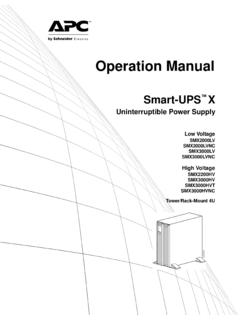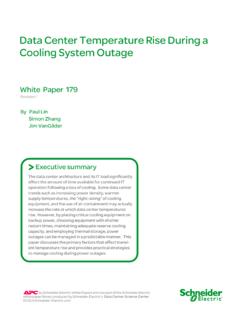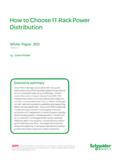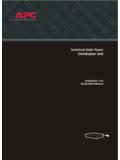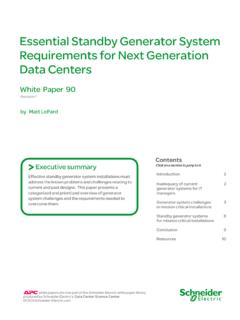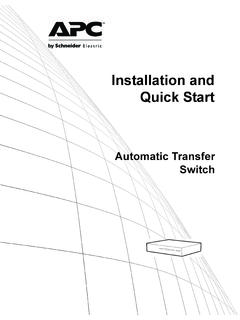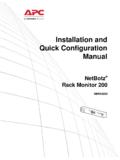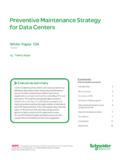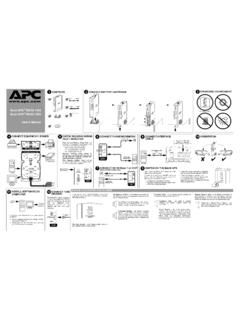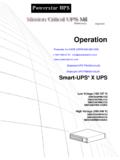Transcription of Battery Technology for Data Centers: VRLA vs. Li-ion
1 Battery Technology for data Centers: vrla vs. Li-ion Executive summary Lithium-ion Battery prices have decreased over the years and are now becoming a via-ble option for data center UPS. This paper provides a brief overview of Li-ion batteries in comparison to vrla batteries for static UPS applications, including optimal chemistries and technologies. A 10-year total cost of ownership (TCO) analysis is provided show-ing li -ion is 39% less than vrla despite their capital cost premium. A sensitivity analysis reveals the TCO drivers. Finally we discuss Li-ion batteries for retrofit and new UPS ap-plications and the effect of temperature on Battery life, runtime, and 0 by Victor Avelar Martin Zacho White Paper 229 RATE THIS PAPER schneider Electric data center Science center White Paper 229 Rev 0 2 Battery Technology for data Centers: vrla vs. Li-ion Lithium-ion ( Li-ion ) batteries have been used commercially for over 20 years in various applications1.
2 Why then have they not been commonly adopted as batteries for static2 data center UPSs? The answer lies in the fact that, like all other applica-tions, Li-ion cells3 weren t available that provided UPS vendors with the right balance of price, energy density, power, safety, and reliability for static UPS applications. However, advancements in Li-ion chemistries and technologies over the last 10 years have provided UPS vendors with realistic options. These advancements have largely been due to requirements set forth by the electric vehicle industry. Figure 1 shows an example of a Li-ion Battery for a 3-phase UPS application. Li-ion batteries do offer legitimate benefits over vrla (valve-regulated lead-acid) including:4 Fewer Battery replacements (perhaps none) required over the life of the UPS eliminates the risk of downtime posed by Battery replacement About three times less weight for the same amount of energy Up to ten times more discharge cycles depending on chemistry, Technology , temperature, and depth of discharge About four times less self-discharge ( slow discharge of a Battery while not in use) Four or more times faster charging , key in multiple outage scenarios However, Li-ion batteries also have two main drawbacks compared to vrla : About two to three times more capex for the same amount of energy due to higher manufacturing cost and cost of required Battery management system Stricter transportation regulations This paper provides a brief overview of Li-ion Battery characteristics compared to vrla .
3 We then analyze the capital cost, operational cost, and total cost of owner-ship (TCO) between these two Battery types. We di scuss Li-ion batteries for retrofit and new static UPS applications. Finally, explain the effect of temperature on Battery life, runtime, and cooling. 1 (last accessed on 2/28/16) 2 This paper applies specifically to static UPS ( double-conversion or delta-conversion). For information on this topic, see White Paper 1, The Different Types of UPS Systems. 3 Note that the term cell refers to the smallest building block of a Battery . Batteries are composed to two or more cells and they are packaged according to specific applications such as for use with UPS. 4 (last accessed on 2/28/16) Introduction Figure 1 Li-ion Battery module for 3-phase UPS applications (left) and multiple modules connected in a cabinet schneider Electric data center Science center White Paper 229 Rev 0 3 Battery Technology for data Centers: vrla vs.
4 Li-ion At a general level, there are some common characteristics with all lithium-ion cells. For example, they are all rechargeable, they all use electrolyte, and lithium ions move between the electrodes. However, some specific characteristics depend on the chemistry and Technology . The chemistry refers to the elements that result in a chemical reaction that charges and discharges the cell. The chemistry determines the cell voltage. Technology refers to other design characteristics ( electrode thickness, electrolyte composition, coatings, additives, etc.) that ultimately deter-mine the amount of energy (watt-hours), power (watts), energy density (watt-hours/kg), power density (watts/kg), service life, impact of temperature, stability, and a host of other characteristics. The following sections provide a brief overview of some key Li-ion characteristics and how they compare with vrla batteries in static UPS applications. White Paper 231, FAQs for Using Lithium-ion Batteries with a UPS, provides more information on these characteristics.
5 Optimal chemistry UPS applications require batteries that can provide a large amount of power capaci-ty for 5- 10 minutes. Therefore, UPS applications require Li-ion chemistries and technologies that can supply a large amount of current in a short amount of time while maintaining a safe internal cell temperature. Compared to lead-acid chemis-try, li -ion chemistries provide higher energy and power per unit weight, typically referred to as energy density (Wh/kg) and power density (W/kg). Power cells vs. energy cells As stated above, UPS applications require that batteries supply a large amount of current and power in 5- 10 minutes. In this regard, a key distinction between Li-ion and vrla batteries is how much of the Battery s energy capacity remains after the 5- 10 minutes of runtime. A power cell is designed to provide a relatively large amount of power in a short amount of time while using nearly all of the Battery s energy capacity. In a UPS application for example, a power Battery solution could provide 1-2 minutes of runtime at full load while discharging about 80% of the Battery en-ergy capacity.
6 An energy cell is designed to provide a relatively small amount of power over a long period of time. In a UPS application, an energy Battery solution could provide the same amount of power over the same amount of time (as above) but will only discharge a 10- 30%5 of the Battery s energy capacity. This basically means that for this application, an energy Battery solution is oversized (in energy) and will likely provide much more runtime than required. Depending on the price of the energy cell relative to the price of the power cell, it could be less expensive to use an oversized energy Battery solution in a UPS application, rather than a rightsized power Battery solution. Figure 2 i l-lustrates the relationship between energy and power for various energy stor-age technologies along with the corresponding impact on runtime. The down-ward curve for each of the lines represents the limitation of the Battery to sup-ply its full energy capacity at shorter runtimes.
7 Note the relative positions of lead acid and Li-ion for both energy density and power density. A key conclusion is that li- ion batteries can be designed as power cells or energy cells. Conversely, vrla Battery chemistry and Technology limit their design solely as energy cells. 5 Figure 7, (last accessed on 2/28/16) Li-ion Battery overview Energy vs. Power Energy (measured in watt-hours) is how long power (measured in watts) is supplied to a load. The following example explains this difference. Battery power (W) = volts x amps. If a Battery system supplies 100 volts at 10 amps, it can support 1,000 W of load. Battery energy (Wh) = power x hours. If a Battery system supplies 1,000 watts to a load for 6 minutes ( hours), it supplies 100 Wh of energy. schneider Electric data center Science center White Paper 229 Rev 0 4 Battery Technology for data Centers: vrla vs. Li-ion Source: Lifetime How long a Battery lasts before you need to replace it is what really matters when it comes to Battery lifetime.
8 However, it s important to understand the different metrics suppliers use to measure lifetime. Of particular importance is service life. This is the estimated time a Battery will last before it reaches 80% of its energy capacity, the typical definition of end of life for batteries. Service life assumes the Battery is operating under real world conditions for a stated application and is therefore highly variable. In contrast, calendar life is the estimated time a Battery will last if it were to remain trickle charged for its entire life with no power outages at a specified temperature, usually 25 C (77 F). vrla batteries have a service life in the range of 3- 6 years whereas Li-ion batteries can have a service life upwards of 10 years (estimated using accelerated life testing). Note that it will be several years before data on actual service life becomes available for newer Li-ion batteries, however, some Li-ion batteries offer warranties in the 10 year range as a hedge against the lack of service data .
9 Footprint Due to the higher energy densities of Li-ion batteries, they are much smaller in terms of footprint or volume compared to vrla . This space savings is especially attrac-tive to colocation data centers or data centers with high real estate costs. Weight Similar to footprint, the higher energy density of Li-ion also contributes to its lighter weight compared to vrla . Weight contributes to increased transportation costs. Battery monitoring Battery monitoring systems (BMS) are usually an add-on for traditional vrla Battery solutions. Some data center operators buy a BMS to prolong the life of the Battery system. However, Li-ion batteries come with a BMS by default because these batteries require full control of charging and discharging to prevent unsafe tempera-tures inside the Li-ion cells. Safety Safety is top of mind when it comes to batteries especially when it comes to Li-ion batteries. The important thing to remember about UPS applications is that UPS vendors need to work closely with reputable Li-ion vendors to find the best combina-tion of chemistry, Technology , cell packaging, and Battery management for specific Figure 2 Chart showing relationship between energy and power density also known as a Ragone plot schneider Electric data center Science center White Paper 229 Rev 0 5 Battery Technology for data Centers: vrla vs.
10 Li-ion UPSs. See White Paper 231, FAQs for Using Lithium-ion Batteries with a UPS, for more information on safety hazards. Regulations There are various regulations around shipping any kind of Battery including Li-ion or vrla . These shipping regulations tend to be stricter with Li-ion chemistries due to the higher energy densities and higher volatility of certain chemistries. Using total cost of ownership as a metric is gaining traction in certain data center investments like cooling system economizer modes and UPS batteries. In the case of li -ion batteries, certain power cell chemistries and technologies present a favora-ble TCO over a 10 to 15 year period compared to vrla batteries. This happens to be the typical life span range of a UPS before replacement is needed. Some Li-ion cost studies are available, but are not entirely useful for various rea-sons: They are focused on electric vehicle or long-runtime applications which require energy cells as opposed to power cells, ideal for UPS applications.
